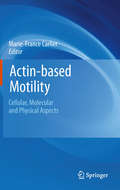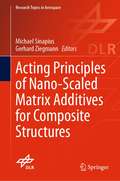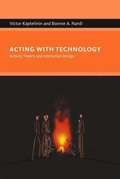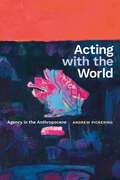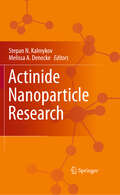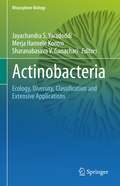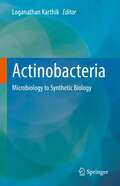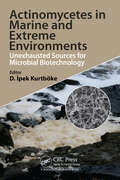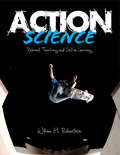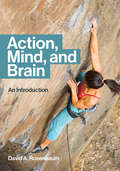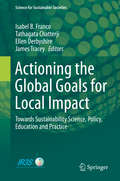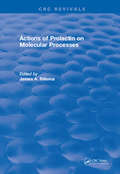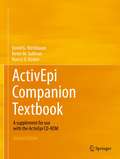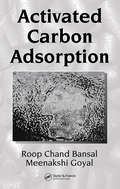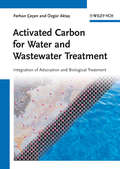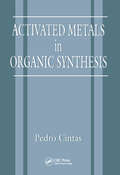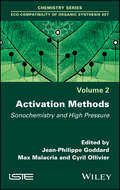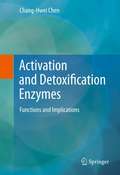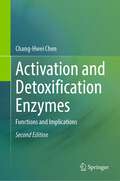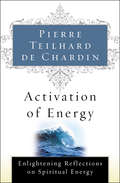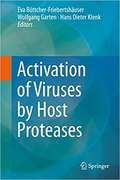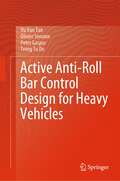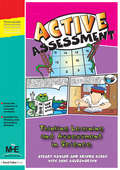- Table View
- List View
Actin-based Motility: Cellular, Molecular and Physical Aspects
by Marie-France CarlierThis book presents the cellular, molecular and physical aspects of production of force and movement by self-assembly of actin, one of the most abundant protein in cells, into cytoskeletal filaments. « Actin-based motile processes » are responsible for a very large variety of motile activities of cells in their physiological and pathological states, covering chemotactic locomotion, embryonic and metastatic cell migration, wound healing, eukaryotic cytokinesis and bacterial plasmid segregation, endocytic and phagocytic activities, as well as morphogenetic processes like axis patterning in early embryo, axonal growth in brain development, immune response and synaptic plasticity processes at the origin of learning and memory. The different chapters of the book describe how the multidisciplinary multiscale approaches taken in the recent years have explored the molecular and physical mechanisms at the origin of force and movement produced by actin self-assembly. The chosen topics show how advances have been made in the field of cell motility due to progress in live cell imaging, light microscopy, improved resolution in the structure of large protein assemblies, biochemical analysis and mathematical modeling of actin assembly dynamics and development of nanotechnologies allowing to measure forces in the range of pico- to nano-newton produced by actin assemblies.
Acting Principles of Nano-Scaled Matrix Additives for Composite Structures (Research Topics in Aerospace)
by Michael Sinapius Gerhard ZiegmannThe book explores the effect of nanoscale matrix additives along the four levels of material formation, particle-resin interaction, the influence of nanoparticles on the processability of the polymer, the influence of nanoparticles on polymer curing and the influence of nanoparticles on the fiber plastic composite. Fiber-reinforced plastics have a significantly higher lightweight construction potential in components with a primary single- or biaxial stress state compared to isotropic metals. At the same time, their insensitivity to corrosion and their advantageous fatigue properties can help to reduce maintenance costs. Due to their outstanding specific mechanical properties, they are among today's high-performance lightweight construction materials. These properties make them particularly attractive in the field of mobility. However, as soon as the matrix properties dominate the mechanical properties, e.g. in the case of fibre-parallel compressive strength, significant weaknesses become apparent in the mechanical properties. Here, one approach is to significantly increase the matrix properties through nanoscale ceramic additives and at the same time to guarantee the processability of the resin.
Acting with Technology: Activity Theory and Interaction Design
by Victor Kaptelinin Bonnie A. NardiActivity theory holds that the human mind is the product of our interaction with people and artifacts in the context of everyday activity. Acting with Technology makes the case for activity theory as a basis for understanding our relationship with technology. Victor Kaptelinin and Bonnie Nardi describe activity theory's principles, history, relationship to other theoretical approaches, and application to the analysis and design of technologies. The book provides the first systematic entry-level introduction to the major principles of activity theory. It describes the accumulating body of work in interaction design informed by activity theory, drawing on work from an international community of scholars and designers. Kaptelinin and Nardi examine the notion of the object of activity, describe its use in an empirical study, and discuss key debates in the development of activity theory. Finally, they outline current and future issues in activity theory, providing a comparative analysis of the theory and its leading theoretical competitors within interaction design: distributed cognition, actor-network theory, and phenomenologically inspired approaches.
Acting with the World: Agency in the Anthropocene
by Andrew PickeringIn the Anthropocene our actions are coming home to roost. Global warming, species extinctions, and environmental disasters are the dark side of our mastery of nature. In Acting with the World, Andrew Pickering identifies a different pattern of being and doing that can evade this dark side, a pattern that he calls acting-with the world. In contrast to our usual practice of acting on the world, acting-with foregrounds nonhuman or more-than-human agency and aims to attune our practices to the propensities of nature. Pickering explores examples of acting-with from around the globe, including flood control on the Mississippi River, ecosystem restoration on the Colorado River, the Room for the River project and rewilding in the Netherlands, natural farming in Japan, Aboriginal fire techniques in Australia, and Amazonian shamanism. Pickering argues that acting-with intimately and gracefully plugs us into nature, undercuts the Anthropocene from below, and offers a constructive approach to addressing otherwise intractable wicked problems.
Actinide Nanoparticle Research
by Melissa A. Denecke Stepan N. KalmykovThis is the first book to cover actinide nano research. It is of interest both for fundamental research into the chemistry and physics of f-block elements as well as for applied researchers such as those studying the long-term safety of nuclear waste disposal and developing remediation strategies. The authors cover important issues of the formation of actinide nano-particles, their properties and structure, environmental behavior of colloids and nanoparticles related to the safe disposal of nuclear wastes, modeling and advanced methods of characterization at the nano-scale.
Actinobacteria: Ecology, Diversity, Classification and Extensive Applications (Rhizosphere Biology)
by Jayachandra S. Yaradoddi Merja Hannele Kontro Sharanabasava V. GanachariThrough this book, the readers will learn about the different aspects of Actinobacteria- beginning with its ecology and occurrence, to the ways of its adaptation to harsh climates, and finally to its practical applications. The book also presents methods of identifying and characterizing this diverse group of bacteria through advanced techniques like MALDI-TOF, 16S rRNA analysis, etc. Different chapters describe the various biotechnological applications of Actinobacteria, including bioremediation, secondary metabolite production, and in producing antibiotics, anti-cancer therapeutics. It also provides insights into the applications in agriculture and forestry by inhibiting plant pathogenic bacteria's growth.
Actinobacteria: Microbiology to Synthetic Biology
by Loganathan KarthikThis book summarizes the basics of actinobacteria, from microbiology to synthetic biology. It focuses on diversity, NRPS, sesquiterpenes, lantipeptide, bioinformatics apparatuses, cloning, CRISPR, reverse engineering, FDA supported medications, and marine actinobacteria. It also covers the latest trends in drug discovery from actinobacteria, and introduces several recently developed bioinformatics and synthetic biology tools to explore new antibiotics from actinobacteria. Many natural products such as polyketides, isoprenoids, phenazines, peptides, indolocarbarbazoles, sterols, and others have been isolated and characterized from actinobacteria. Some products are synthesized by the non-ribosomal peptide synthetases (NRPSs), polyketide synthases (PKSs), or other functional genes. Although genome sequencing has uncovered the differing qualities of these chemicals, recognizing new items and their biosynthetic pathways is still under examination.Cryptic metabolic pathways have been explored using molecular techniques or culture-dependent approaches. In recent years, researchers’ primary interest is to identify the specific conditions or agents that wake the cryptic antibiotics. Several bioinformatics and synthetic biology tools were developed to explore new antibiotics from actinobacteria.The book comprises 14 chapters with different aspects of application and utilization of actinomycetes from the microbiology; systems biology, pharmacology of natural products, bioinformatics, actinomycete and its diversity, CRISPR, artificial Intelligence, synthetic biology, metabolic engineering, expressional studies, and biosynthetic gene clusters. The book delivers useful information on actinomyces to researchers, novices in genome designing, specialists, clinicians, policymakers, and professionals.
Actinomycetes in Marine and Extreme Environments: Unexhausted Sources for Microbial Biotechnology
by D. İpek KurtbökeThe discovery and development of antibiotics has been one of the most significant advances in medicine. In a golden era lasting from the 1940s to the late 1960s, antibiotic research provided mankind with a wide range of structurally diverse and effective agents for the treatment of microbial infections. Since then, actinomycetes, most notably members of the genus Streptomyces, have uninterruptedly proved to be a particularly rich source of antibiotics and other therapeutic and biotechnologically important compounds. This book brings together expert actinomycetologists to communicate the importance of finding novel antibiotic producing actinomycetes in extreme and marine environments in the light of molecular advances.
Action Science: Relevant Teaching and Active Learning
by William H. RobertsonPut student engagement on the fast-track Think action sports like skateboarding and BMX have nothing to do with physical science? Think again, especially as they relate to fundamental physics concepts like motion, force, and simple machines—not to mention the problem solving required. What’s more, because kids will want to, observing action sports is a perfect vehicle for promoting self-directed and collaborative learning . . . with Action Science as your driver’s manual. Through a combination of book and video, Bill Robertson provides all the materials you’ll need to get started, with the NGSS very much in full view. Inside and outside, you’ll find: Detailed instructional methods on momentum, center of gravity, inertia, and centrifugal and centripetal forces Hands-on classroom activities and experiments, including some utilizing common household materials Captivating video via QR codes of top professional and amateur extreme sports athletes demonstrating authentic, high-flying maneuvers Robertson, an associate professor in science and technology education at the University of Texas at El Paso--and an avid skateboarder—has extensively piloted the Action Science program. It works! "This is an outstanding resource for any middle school science teacher trying to engage unmotivated students or implement problem-based learning strategies in a way that is exciting and meaningful!" --Melissa Miller, Middle School Science Teacher Lynch Middle School Farmington, AR
Action Science: Relevant Teaching and Active Learning
by William H. RobertsonPut student engagement on the fast-track Think action sports like skateboarding and BMX have nothing to do with physical science? Think again, especially as they relate to fundamental physics concepts like motion, force, and simple machines—not to mention the problem solving required. What’s more, because kids will want to, observing action sports is a perfect vehicle for promoting self-directed and collaborative learning . . . with Action Science as your driver’s manual. Through a combination of book and video, Bill Robertson provides all the materials you’ll need to get started, with the NGSS very much in full view. Inside and outside, you’ll find: Detailed instructional methods on momentum, center of gravity, inertia, and centrifugal and centripetal forces Hands-on classroom activities and experiments, including some utilizing common household materials Captivating video via QR codes of top professional and amateur extreme sports athletes demonstrating authentic, high-flying maneuvers Robertson, an associate professor in science and technology education at the University of Texas at El Paso--and an avid skateboarder—has extensively piloted the Action Science program. It works! "This is an outstanding resource for any middle school science teacher trying to engage unmotivated students or implement problem-based learning strategies in a way that is exciting and meaningful!" --Melissa Miller, Middle School Science Teacher Lynch Middle School Farmington, AR
Action, Mind, and Brain: An Introduction
by David A. RosenbaumAn engaging and accessible introduction to the psychology and neuroscience of physical action.This engaging and accessible book offers the first introductory text on the psychology and neuroscience of physical action. Written by a leading researcher in the field, it covers the interplay of action, mind, and brain, showing that many core concepts in philosophy, psychology, neuroscience, and technology grew out of questions about the control of everyday physical actions. It explains action not as a &“one-way street from stimuli to response&” but as a continual perception-action cycle. The informal writing style invites students to think through the evidence step by step, helping them develop general thinking stills as well as learn specific facts. Special emphasis is placed on the role of underrepresented groups. The book discusses the intellectual background of the field, from Plato to Kant, Dewey, and others; applications and methods; and the physical substrates of action—bones, tendons, ligaments, muscles, and nerves. It considers the control of actions in space; learning, and the roles of nature and nurture; feedback; feedforward, or anticipated feedback; and degrees of freedom—the multiple ways of getting things done and three methods for narrowing the alternatives. The book is generously illustrated, including many images of thinkers who contributed to the field.
Actioning the Global Goals for Local Impact: Towards Sustainability Science, Policy, Education and Practice (Science for Sustainable Societies)
by Isabel B. Franco Tathagata Chatterji Ellen Derbyshire James TraceyThis book highlights the value of sustainability science in newly emerging and innovative approaches to research, education, capacity building and practice in order to transform rhetoric into impact sustainability. Presenting case studies from various industries, sectors and geographical contexts targeting the seventeen (Sustainable development Goals (SDGs) outlined in the 2030 Agenda, it provides insightful recommendations to create sustainable impact while at the same time achieving the global goals. The book addresses the fundamental question of how sustainability rehtoric can be transformed into impact sustainability research, education and capacity building and as a result, how existing approaches in science, curricula and practice are mitigating the demands emerging from addressing global sustainable development in an impactful and innovative manner. Providing recommendations for impact sustainability in science, curriculum on how to address pressing sustainability issues and contribute toward achieving the SDGs, this book is an essential reference for both academics and professionals.
Actions of Prolactin On Molecular Processes
by James A. RillemaIt is well established tht the intial interaction of prolactin with its target cells is with specific receptor molecules located on the external surface of the plasma membrane. Subsequent to the prolactin-receptor interaction, however, the molecular events that culminate in the regulation of biological processes are not totally understood. This book was assembled to review and analyse the currently available information relative to the molecular events involved in the actions of prolactin on cells. Hopefully, the assimilation of this information will provide the basis for ultimately determining the sequence of molecular reactions by which prolactin expresses its biological responses.
ActivEpi Companion Textbook: A supplement for use with the ActivEpi CD-ROM
by David G. Kleinbaum Kevin M. Sullivan Nancy D. BarkerThis Companion Textbook supplements the ActivEpi CD-ROM, sold separately. The ActivEpi CD-ROM provides a multimedia presentation of concepts, commonly taught in an introductory epidemiology course. ActivEpi mixes a full array of media to motivate, explain, visualize and apply epidemiological concepts. Virtually all of the material on the ActivEpi CD-ROM is included in the Companion Textbook. Because individuals differ in their learning skills, the ActivEpi CD-ROM and the ActivEpi Companion Textbook offer readers different but related options on how to learn epidemiology. The Textbook can be used as a hardcopy reference of the textual materials contained on the CD-ROM, as a resource for the practice exercises, as a general reference, or even a self-contained textbook. ActivEpi includes 15 lessons and over 50 hours of content via more than 250 launchable activities and homework exercises. It can be used in a variety of teaching formats: distance learning, self-paced learning, on-campus courses, and short courses. For the latest additions to ActivEpi, visit David Kleinbaum's website.
Activated Carbon Adsorption
by Roop Chand Bansal Meenakshi GoyalHigh surface area, a microporous structure, and a high degree of surface reactivity make activated carbons versatile adsorbents, particularly effective in the adsorption of organic and inorganic pollutants from aqueous solutions. Activated Carbon Adsorption introduces the parameters and mechanisms involved in the activated carbon adsorption
Activated Carbon for Water and Wastewater Treatment: Integration of Adsorption and Biological Treatment
by Özgür Aktas Ferhan CecenThis monograph provides comprehensive coverage of technologies which integrate adsorption and biological processes in water and wastewater treatment. The authors provide both an introduction to the topic as well as a detailed discussion of theoretical and practical considerations. After a review of the basics involved in the chemistry, biology and technology of integrated adsorption and biological removal, they discuss the setup of pilot- and full-scale treatment facilities, covering powdered as well as granular activated carbon. They elucidate the factors that influence the successful operation of integrated systems. Their discussion on integrated systems expands from the effects of environmental to the removal of various pollutants, to regeneration of activated carbon, and to the analysis of such systems in mathematical terms. The authors conclude with a look at future needs for research and develoment. A truly valuable resource for environmental engineers, environmental and water chemists, as well as professionals working in water and wastewater treatment.
Activated Metals in Organic Synthesis (New Directions In Organic And Biological Chemistry Ser.)
by P. CintasActivated Metals in Organic Synthesis discusses fundamental principles of the generation of activated, highly reactive metals, and their applications in organic synthesis. Following an introductory chapter on basic forms of metals the chapters in Part 1 are devoted to common strategies utilized for the preparation of active metals. These strategies include vaporization and subsequent co-condensation of metal atoms, in addition to depassivating methods employed commonly in laboratory syntheses. Chapters in Part 2 discuss relevant organic transformations in which metal activation plays a crucial role. Specific topics covered include metal-induced reductive methods; pinacolic, Reformatsky-, and Barbier-type reactions; McMurry ketone-olefin coupling; and the Bernet-Vasella reaction. Each chapter is followed by literature citations ranging from specific references to significant reviews. Many structural formulas are provided, making it easy to follow each synthesis. The book will be an important reference for students, organic chemists, and researchers in all areas of organometallic chemistry.
Activating Our 12-Stranded DNA: Secrets of Dodecahedral DNA for Completing Our Human Evolution
by Ruslana Remennikova• Reveals how vibration and intention can transform DNA from the standard double helix to its 12-stranded form, unlocking your physical and spiritual potential• Explores the intimate relationship of water and DNA and how they both react to sound and consciousness• Shares ten specific frequencies that resonate with DNA as well as techniques and meditations to activate your 12-stranded DNA for emotional and physical healing, resolution of ancestral trauma, and conscious evolutionIn this vibrant guidebook, sound healer and former corporate scientist Ruslana Remennikova reveals how, through vibration and intention, you can shapeshift DNA from the standard double helix to its 12-stranded, dodecahedral form—thereby unlocking your spiritual potential and opening the way for deep healing of the past, the present, and the future of your deeper self.Examining the alchemy behind the 12 strands of our DNA, the author looks at the intimate relationship between water and DNA, showing how both respond to vibrational frequencies as well as to consciousness. She also shows how unresolved grief creates oxidative stress in the body that targets our cellular mitochondrial DNA, leading to psychological and physical illnesses. She explains how sound can transform our DNA into an evolutionary activator and healing mechanism, helping the body to detox, resolve grief and trauma, and address stress-induced imbalances at the cellular level.Sharing techniques and meditations that help you activate all 12 strands of your DNA, the author reveals the revolutionary healing powers inherent in each of us for personal healing, spiritual transformation, and the completion of our human evolution.
Activation Methods: Sonochemistry and High Pressure
by Jean-Philippe Goddard Max Malacria Cyril OllivierActivation Methods examines recent improvements in the utilization of ultrasonic waves and pressurized gases to generate reactions. A straightforward method to use, sonochemistry allows chemical reactions to be carried out under ultrasound without the need for external heat, reagents or catalysts – leading to high yields and the production of a minimum amount of waste. This book presents an overview of the main applications of sonochemistry in green organic chemistry, with an emphasis on texts published within the last few years. High-pressure chemical reactions offer innovative solutions to problems relating to synthesis. They allow access to new products and a further understanding of reaction mechanisms. This book presents the characteristics of hyperbaric activation, which allow the integration of an arsenal of tools for green chemistry, such as the lowering of energy costs and of by-products, as well as the possibility of using substrates that are sterically congested and generally inert.
Activation and Detoxification Enzymes: Functions and Implications
by Chang-Hwei ChenHumans are exposed to foreign compounds such as drugs, household products and environmental chemicals by swallowing or breathing. Also, food is considered a foreign compound. Such foreign compounds can be non-essential and non-functional to life, and commonly are referred to as xenobiotics. Some xenobiotics are not toxic; however, many of them are potentially toxic or become toxic after conversion to metabolic intermediates. A considerable number of foreign compounds belong to non-polar, lipophilic substances. Lipophilic compounds are not soluble in water. Metabolic conversion of lipophilic foreign compounds to facilitate their removal from the body is essentially carried out by biochemical reactions catalyzed by two classes of metabolizing enzymes, namely, activation enzymes and detoxification enzymes. Activation enzyme-catalyzed functionalization reaction introduces a functional group to a lipophilic compound. Functionalization modifies many foreign compounds to form reactive intermediates capable of interacting with cellular components (proteins, DNA and lipids), leading to a variety of conditions for diseases. Functionalized compounds are further metabolized through detoxification enzyme-catalyzed reactions, which result in an increase in the solubility of parent compounds and an inactivation of metabolic intermediates, thus facilitating their excretion from the body. To minimize the exposure of potentially toxic metabolic intermediates, it is essential to keep them at a minimum level. Extensive investigations have revealed that foreign compound-metabolizing enzymes exhibit genetic polymorphisms. Variations in their activities can produce different results as to the susceptibility to potential toxic effects. Moreover, the expressions of activation enzymes and detoxification enzymes are inducible. A number of chemical compounds are capable of acting as modulators for these two classes of enzymes. These findings have lead to the proposal of modulating metabolizing enzymes as a useful approach for human health benefits. Importantly, many of these chemical compounds are present in human daily diets. There are many advances that have been made in the past decades towards the understanding of functions and implications of activation enzymes and detoxification enzymes. An organized, concise overview is needed for the readers who are initially exposed to this important subject, particularly for students and researchers in the areas of biomedical sciences, biochemistry, nutrition, pharmacology and chemistry. This book is intended to serve this purpose as an introduction to the subject. Furthermore, major topics in the book, excluding catalytic reactions and structural properties, may have interest to other readers who have knowledge of basic sciences and understanding enzyme related information. The book discusses subjects associated with foreign compound metabolizing enzymes with emphasis on biochemical aspects, including lipophilic foreign compounds, catalytic properties, reactive intermediates, biomedical and biochemical effects, genetic polymorphisms, enzyme inducibility, enzyme modulation for health benefits, dietary related enzyme modulators, and structural characteristics of enzyme inducers.
Activation and Detoxification Enzymes: Functions and Implications
by Chang-Hwei ChenThis book discusses the many advances in the understanding of the functions and implications of activation and detoxification enzymes. This organized, concise overview will meet the needs of those who are initially exposed to this important subject, particularly for students and researchers in the areas of biomedical sciences, biochemistry, nutrition, pharmacology, and chemistry. The book will also be valuable to advanced researchers. The book discusses subjects associated with foreign-compound-metabolizing enzymes with emphasis on biochemical aspects, including lipophilic foreign compounds, activation and detoxification enzymes, metabolic enzyme catalytic properties, reactive metabolic intermediates, biomedical and biochemical effects, genetic polymorphisms, enzyme inducibility, enzyme modulation for health benefits, dietary-related enzyme modulators, and structural characteristics of enzyme inducers. This new edition is updated throughout andfeatures completely new chapters on Oxidative and Electrophilic Stresses, Metabolite- Mediated Disease Conditions, and Defense Mechanism: Nrf2-ARE Pathway.
Activation of Energy: Enlightening Reflections on Spiritual Energy
by Pierre Teilhard de ChardinThe renowned Jesuit thinker explores science, theology, and the course of human evolution. Following in the footsteps of his earlier works, this collection of essays from Pierre Teilhard de Chardin brings greater clarity to the stunning potential of human energy if it is properly channeled, as he describes, &“upward and outward.&” While energy wrongly directed appears as depression, drug addiction, and violence, this legendary scholar—a priest who earned a doctorate in geology and studied the sciences extensively—promises that spiritual energy channeled correctly will become a true force in the universe, far outdistancing the potential of technological advance. &“Like other great visionary poets—Blake, Hopkins, Yeats—Teilhard engages the reader both intellectually and sensually.&” —The Washington Post Book World
Activation of Viruses by Host Proteases
by Eva Böttcher-Friebertshäuser Wolfgang Garten Hans Dieter KlenkPresents recent findings on this topic.<P><P> Deals with all aspects of the role of proteases in virus activation.<P> Explores the topic from different points of view.<P>This book will give an overview on viruses undergoing proteolytic activation through host proteases. The chapters will be organized in three themed parts, the first part describing respective viruses and their characteristics in detail. In the second part the molecular and cellular biology of the proteases involved as well as their physiological functions will be further explored. The third part will contain a chapter on protease inhibitors that are promising tools for antiviral therapy.<P> This book will engage scholars in virology and medical microbiology as well as researchers with an interest in enzymology and protein structure and function relationship.
Active Anti-Roll Bar Control Design for Heavy Vehicles
by Olivier Sename Peter Gaspar Vu Van Tan Trong Tu DoThis book provides a comprehensive overview of active anti-roll bar systems on heavy vehicles as one of the most effective solutions for improving the roll stability of these vehicles. Due to the characteristics of these vehicles with heavy loads and high center of gravity, the possibility of roll instability occurs frequently and causes serious consequences for human life, vehicles, and traffic infrastructure. The book gives readers an in-depth survey of the roll instability characteristics of heavy vehicles such as single-unit trucks with rigid and flexible frames, and tractor semi-trailers. It then introduces an active anti-roll bar system, the electro-hydraulic actuators which use control methods such as LQR optimal and H∞ robust controller design. This work introduces a new control method, which is a combination of robust control with the linear parameter varying system (H∞/LPV). The validation of the new hybrid method is carried out using the nonlinear truck model from the TruckSim® software to assess the roll stability of heavy vehicles in order to limit the rollover accident. A number of examples are provided to illustrate the research results, which helps the readers have a practical and easy approach that can be applied to other active anti-roll bar systems for most forms of transport vehicles in general. This book caters to academics and practitioners who are interested in active anti-roll bar systems for the typical heavy vehicle available worldwide.
Active Assessment for Science: Thinking, Learning and Assessment in Science
by Anne Goldsworthy Brenda Keogh Stuart NaylorEverybody seems to be talking about assessment for learning. This book shows how to do it. Using a highly creative approach it explains in detail how assessment, thinking and learning can be integrated in science lessons. More than 30 different assessment techniques are described, with each one illustrated for two different age ranges.Concise teachers' notes for each technique explain:what the approach ishow you use it for assessmenthow you can manage it in the classroomhow it helps with learning.Electronic versions of the activities are provided on the accompanying downloadable resources.
